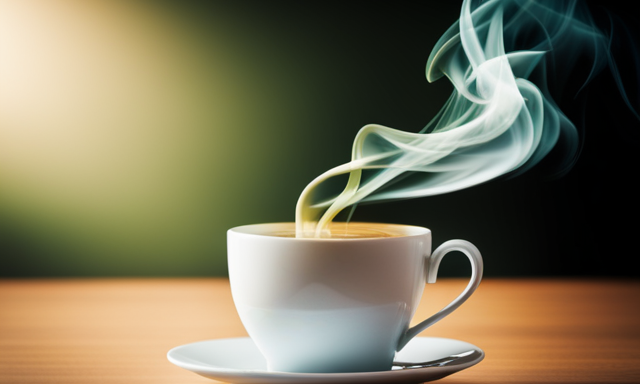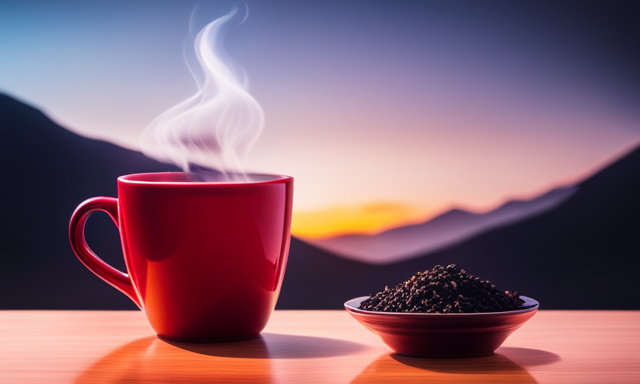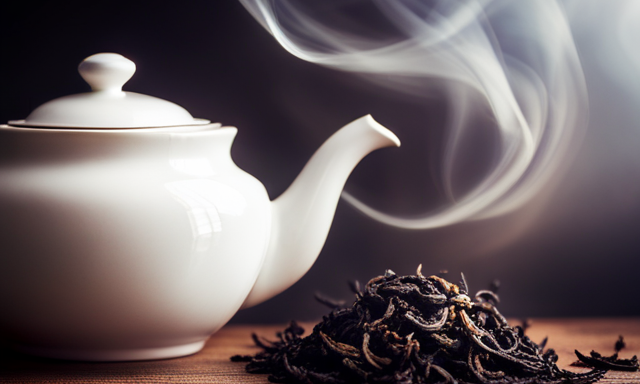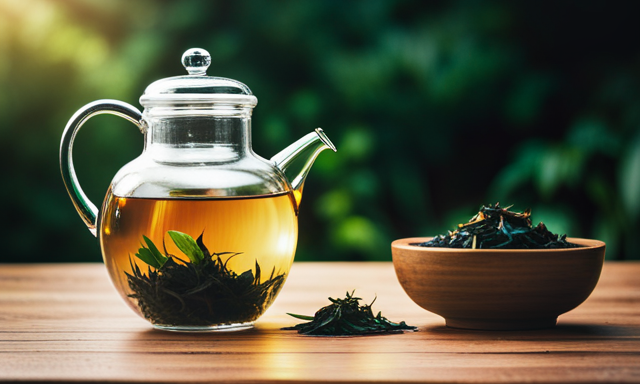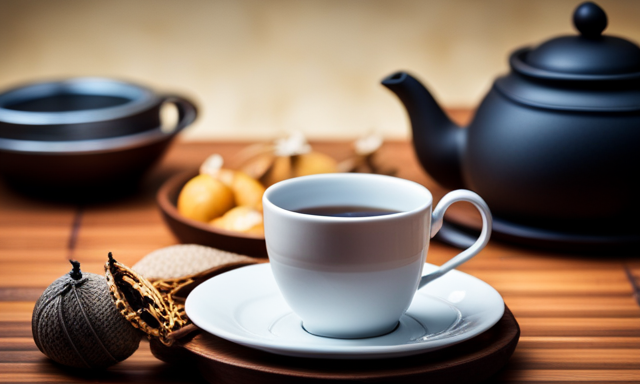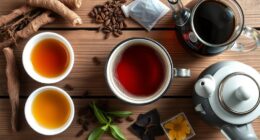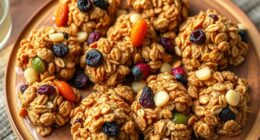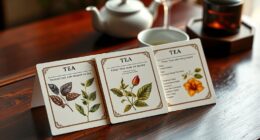Oolong tea, a tantalizing treasure, tempts taste buds with its unique flavor profile and rich history. As a tea enthusiast, I am thrilled to share my knowledge and passion for this remarkable beverage. So, what kind of tea is oolong tea? Let me enlighten you.
Originating in China, oolong tea falls somewhere between green and black tea in terms of oxidation. It boasts a diverse range of flavors, from floral and fruity to toasty and nutty. But it’s not just about the taste; oolong tea also offers numerous health benefits, including improving digestion, boosting metabolism, and promoting heart health.
With its distinct varieties, such as Tie Guan Yin and Da Hong Pao, oolong tea caters to a variety of palates. And let’s not forget its culinary uses, where it can be incorporated into desserts or used as a marinade for meats.
From its cultural significance to its global popularity, oolong tea continues to captivate tea lovers around the world. So, join me on an exploration of oolong tea, where we will delve into its origins, brewing techniques, and recommended brands and flavors. Get ready to savor the enchanting essence of oolong tea!
Key Takeaways
- Oolong tea is rich in symbolism, with various elements representing resilience, purity, power, longevity, and wisdom.
- Traditional tea preparation techniques involve heating the water, steeping the leaves, enhancing taste and appreciation, creating an immersive experience, and connecting with tradition.
- Oolong tea has a significant place in literature and art, often symbolizing life’s complexities, solace, and enlightenment, and inspiring artists and writers.
- Oolong tea has gained popularity globally, especially in Western countries, due to its unique flavor profile, health benefits, cultural significance, and artistic representation.
The Origins of Oolong Tea
Oolong tea has its origins in China, where it has been grown and enjoyed for centuries. The cultivation process of oolong tea is quite intricate and requires skilled tea farmers. It starts with carefully selecting the tea leaves, which are then withered under the sun. After that, the leaves are gently shaken to bruise the edges, allowing for oxidation to occur.
This oxidation process is what gives oolong tea its unique flavor profile. The level of oxidation can vary, leading to different types of oolong tea with varying characteristics. Some oolong teas are lightly oxidized, resulting in a floral and delicate taste, while others are more heavily oxidized, resulting in a darker, richer flavor.
Now, let’s delve into the characteristics of oolong tea and discover its true beauty.
The Characteristics of Oolong Tea
Contrary to popular belief, oolong tea is like a harmonious symphony of flavors dancing on your taste buds. Its taste profile is a delicate balance between the boldness of black tea and the freshness of green tea. Oolong tea exhibits a wide range of flavors, from floral and fruity to toasty and nutty. This diversity is a result of the unique processing methods used to create oolong tea. The leaves are partially oxidized, allowing them to retain some of the characteristics of both black and green tea. The precise level of oxidation, which can vary from 10% to 70%, determines the flavor and aroma of the final product. To better understand the processing methods and taste profiles of oolong tea, refer to the table below:
| Processing Method | Taste Profile |
|---|---|
| Lightly oxidized | Floral and refreshing |
| Moderately oxidized | Fruity and aromatic |
| Heavily oxidized | Rich and toasty |
The characteristics of oolong tea make it a unique and captivating beverage. Its taste and aroma are truly a delight for the senses. Moving on to the health benefits of oolong tea…
The Health Benefits of Oolong Tea
Experience the incredible health benefits that oolong tea offers, as it nourishes your body and invigorates your soul.
Oolong tea is known for its weight loss effects, making it a popular choice among those looking to shed a few pounds. It contains polyphenols and catechins that can help boost metabolism and increase fat oxidation.
Additionally, oolong tea has been shown to improve heart health by reducing cholesterol levels and promoting healthy blood pressure.
The antioxidants present in oolong tea also help to reduce inflammation and strengthen the immune system.
So, not only is oolong tea a delicious beverage, but it also provides numerous health benefits.
Now, let’s explore the different varieties of oolong tea and discover their unique flavors and characteristics.
The Different Varieties of Oolong Tea
Indulge yourself in the diverse array of oolong tea varieties, each offering a distinctive taste and character that will captivate your senses.
Oolong tea comes in different processing methods, resulting in various flavors and aromas. Some popular processing methods include full-oxidized, semi-oxidized, and lightly oxidized. Each method brings out unique qualities, from floral and fruity notes to earthy and toasty undertones.
The best regions for growing oolong tea are Taiwan, China, and Fujian province. These regions provide the perfect climate and soil conditions for cultivating high-quality oolong tea leaves.
Transitioning into the subsequent section about ‘how to brew oolong tea,’ it is important to understand the different varieties and processing methods to achieve the best brew and fully appreciate the nuances of oolong tea.
How to Brew Oolong Tea
Get ready to savor the perfect cup of oolong tea by learning the simple yet effective steps to brew it just right.
To start, it’s crucial to choose high-quality oolong tea leaves. Look for leaves that are tightly rolled and have a vibrant color.
When brewing, use filtered water that is heated to around 190-200°F (88-93°C). Steep the leaves for about 3-5 minutes, depending on your preference for strength.
The best time to drink oolong tea is in the morning or early afternoon, as it contains caffeine which can provide a gentle energy boost. Oolong tea is also known for its digestive benefits, making it a great choice after meals.
Now, let’s delve into the fascinating world of oolong tea and Chinese tea culture.
Oolong Tea and Chinese Tea Culture
After learning how to brew Oolong tea, let’s delve into its fascinating connection with Chinese tea culture. Oolong tea has a rich history that dates back centuries. It originated in the Fujian province of China and quickly gained popularity due to its unique flavor and health benefits.
To understand the significance of Oolong tea in Chinese culture, here are four key aspects to consider:
- Oolong tea is often associated with traditional Chinese tea ceremonies, symbolizing elegance and refinement.
- The production techniques for Oolong tea are highly specialized, involving precise withering, oxidation, and firing processes.
- Oolong tea is known for its diverse range of flavors, from floral and fruity to roasted and earthy, making it a versatile choice for tea enthusiasts.
- The art of Oolong tea appreciation is deeply ingrained in Chinese society, with dedicated tea houses and tea connoisseurs who value its complex flavors and health benefits.
Now, let’s explore the culinary uses of Oolong tea and how it enhances various dishes.
Oolong Tea and its Culinary Uses
Embrace the tantalizing possibilities as Oolong tea weaves its flavorful magic into a myriad of culinary creations. This versatile tea adds a unique twist to both cocktails and desserts, elevating their taste profiles to new heights. When used in cocktails, Oolong tea infuses a delicate yet distinctive flavor that perfectly complements a range of spirits. Its floral and fruity notes harmonize effortlessly with ingredients like gin or rum, resulting in refreshing and intriguing concoctions. In desserts, Oolong tea brings a subtle complexity, enhancing the sweetness with a hint of earthiness. From creamy Oolong tea-infused ice cream to delectable Oolong tea-infused cakes, this tea unlocks a world of culinary delights. As we explore the culinary uses of Oolong tea, we begin to appreciate its cultural significance and the rich traditions it embodies.
Oolong Tea and its Cultural Significance
When it comes to oolong tea, its cultural significance is rich and varied. Symbolism and traditions are deeply intertwined with the consumption of this tea, making it an integral part of many cultural practices.
Additionally, oolong tea has found its way into literature and art, becoming a subject of inspiration for poets, painters, and writers alike.
Its unique flavor and aroma, combined with its cultural allure, have made oolong tea a truly remarkable and influential beverage.
Symbolism and Traditions
Indulge in the rich symbolism and time-honored traditions of oolong tea, as it invites you to savor a profound journey of cultural significance. Oolong tea ceremonies are steeped in symbolism, with each element representing a deeper meaning. The table below illustrates some common symbols and their interpretations:
| Symbol | Meaning |
|---|---|
| Bamboo | Represents resilience and flexibility |
| Lotus | Symbolizes purity and enlightenment |
| Dragon | Signifies power and good fortune |
| Crane | Represents longevity and wisdom |
| Turtle | Symbolizes longevity and protection |
These symbols, along with the traditional tea preparation techniques, create an immersive experience that connects us with centuries of tradition. The precise steps involved in brewing oolong tea, from heating the water to steeping the leaves, are all part of a ritual that enhances the taste and appreciation of this exquisite tea. As we explore oolong tea in literature and art, we discover how its symbolism has inspired countless artists and writers to capture its essence.
Oolong Tea in Literature and Art
Immerse yourself in the captivating world of oolong tea as it weaves its way through the pages of literature and dances across the canvas of art.
Oolong tea has long been a cherished subject in both literature and visual arts, symbolizing elegance, refinement, and tranquility.
In literature, oolong tea is often used as a metaphor for the complexities of life and the quest for inner peace. It is depicted as a drink that brings solace and enlightenment to its characters.
In visual arts, oolong tea is portrayed through delicate brushstrokes and vibrant colors, capturing its essence and inviting viewers to experience its beauty. From ancient Chinese poetry to contemporary paintings, oolong tea holds a significant place in artistic expression.
Transitioning into the subsequent section about the global popularity of oolong tea, its cultural significance and artistic representation have contributed to its widespread appeal and recognition.
The Global Popularity of Oolong Tea
Oolong tea has gained significant popularity in Western countries in recent years. The unique flavor profile and health benefits of oolong tea have made it a favorite among tea enthusiasts.
As a result, there has been a growing demand for oolong tea in the market, with various trends emerging, such as flavored oolong teas and specialty blends.
Oolong Tea in Western Countries
In Western countries, oolong tea has become a trendy and tantalizing beverage. Its unique flavor and health benefits have captivated the taste buds of tea enthusiasts and casual drinkers alike. Oolong tea cultivation has expanded to meet the growing demand, with tea gardens in China, Taiwan, and other regions producing high-quality leaves for consumption. This increase in availability has led to oolong tea finding its way into coffee shops, where it is often served as a refreshing alternative to traditional coffee or black tea. To give you a visual representation of oolong tea’s popularity, take a look at the table below showcasing the top Western countries where oolong tea is consumed:
| Country | Consumption Rank |
|---|---|
| United States | 1 |
| United Kingdom | 2 |
| Canada | 3 |
As oolong tea continues to gain traction, its trends and market demand will be explored in the subsequent section.
Oolong Tea Trends and Market Demand
Oolong Tea in Western countries has gained popularity over the years, with more people embracing its unique flavor and health benefits. Now, let’s delve into the current subtopic: Oolong Tea Trends and Market Demand.
-
Sustainability: Oolong tea is known for its eco-friendly cultivation practices, making it an excellent choice for environmentally conscious consumers.
-
Weight Loss: Oolong tea has been linked to weight loss due to its ability to boost metabolism and aid in fat oxidation. It can be a great addition to a healthy lifestyle and weight management routine.
-
Increasing Demand: The demand for oolong tea is on the rise, as more people are becoming aware of its health benefits and exquisite taste.
-
Diverse Flavors: Oolong tea comes in a wide range of flavors, from floral to fruity, allowing tea enthusiasts to explore and find their preferred taste profiles.
Now, let’s continue our journey by exploring oolong tea: recommended brands and flavors.
Exploring Oolong Tea: Recommended Brands and Flavors
One of the best ways to explore the world of oolong tea is by trying out different brands and flavors that are highly recommended. There are numerous brands that offer a wide variety of oolong teas, each with its own unique flavor profile. Some popular brands include Teavana, Twinings, and The Republic of Tea. These brands offer a range of flavors such as green oolong, black oolong, and fruity oolong. It is important to note that the brewing techniques may vary depending on the brand and flavor. For example, some oolong teas are best brewed at lower temperatures for a shorter period of time, while others require higher temperatures and longer steeping times. As for health benefits, oolong tea is known to boost metabolism, aid in weight loss, and improve digestion. However, it is important to debunk the myth that oolong tea alone can magically shed pounds. Regular exercise and a balanced diet are still key factors in achieving and maintaining a healthy weight. So, grab a cup of oolong tea, explore the various brands and flavors, and enjoy the journey into the world of this fascinating tea.
| Brand | Flavor | Brewing Technique |
|---|---|---|
| Teavana | Green Oolong | 175°F for 2-3 minutes |
| Twinings | Black Oolong | 195°F for 3-4 minutes |
| The Republic of Tea | Fruity Oolong | 180°F for 2-3 minutes |
Frequently Asked Questions
What are the different grades of oolong tea and how do they affect the taste?
Different grades of oolong tea are determined by factors like leaf quality, oxidation level, and processing techniques. The higher the grade, the more delicate and nuanced the flavor profile, influenced by tea harvesting and processing methods.
What is the ideal brewing temperature and steeping time for oolong tea?
The ideal brewing temperature and steeping time for oolong tea are crucial factors to consider. To achieve the perfect cup, it is recommended to brew oolong tea at 190-200°F for 3-5 minutes.
Can oolong tea help with weight loss?
Oolong tea can help with weight loss by boosting metabolism and suppressing appetite. It contains compounds that increase fat oxidation and promote thermogenesis, making it an effective tool for those looking to shed pounds.
Is oolong tea suitable for those with caffeine sensitivity?
Oolong tea is not decaffeinated, so it may not be suitable for those with caffeine sensitivity. However, it does offer health benefits for caffeine-sensitive individuals, such as improved metabolism and reduced stress levels.
How does oolong tea compare to other types of tea in terms of antioxidant content?
Oolong tea has higher antioxidant content compared to green tea. Antioxidants play a crucial role in promoting overall health and well-being by protecting the body against free radicals and reducing oxidative stress.
Conclusion
In conclusion, oolong tea is a true gem in the world of tea. Its rich history, unique characteristics, and numerous health benefits make it a beverage worth exploring.
From the delicate floral notes of Tie Guan Yin to the robust flavors of Da Hong Pao, oolong tea offers a diverse range of flavors to suit every palate.
So why not embark on a journey of taste and culture with a cup of oolong tea? It’s a sip that will transport you to ancient tea gardens and leave you feeling refreshed and invigorated.


